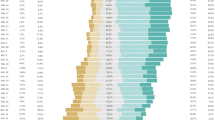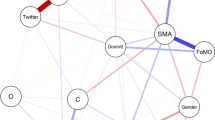Abstract
The present study evaluated the factor structure and psychometric properties of the Beck Depression Inventory-II (BDI-II; Beck, Steer, & Brown, 1996) in the nonclinical sample of 230 young adults. The BDI-II is a revised version of the BDI-IA. We evaluated the fit of three alternative models to the sample data, using confirmatory factor analysis. Results provided support for the fit of the oblique three-factor model. The BDI-II and factor scales had satisfactory coefficient alpha indices. We obtained gender differences on the BDI-II item, total, and factor scale scores. We examined the relations of the BDI-II with demographic variables and with other self-report measures of social desirability, anxiety, depression, stress, and self-esteem. We also examined the issue of whether specific self-report measures of anxiety and depression assess separate or different constructs. We discuss the limitations of the present study.
Similar content being viewed by others
References
American Psychiatric Association (1994).Diagnostic and statistical manual of mental disorders 4th ed. Washington, DC: APA.
Beck, A. T., & Steer, R. A. (1990).Manual for the Beck Anxiety Inventory. San Antonio, TX: Psychological Corp.
Beck, A. T., & Steer, R. A. (1993).Manual for the Beck Depression Inventory. San Antonio, TX: Psychological Corp.
Beck, A. T., Steer, R. A., Ball, R., & Ranieri, W. F. (1996). Comparison of Beck Depression Inventory-I and -II in psychiatric outpatients.Journal of Personality Assessment, 67, 588–597.
Beck, A. T., Steer, R. A., & Brown, G. K. (1996).Manual for the Beck Depression Inventory-II. San Antonio, TX: Psychological Corp.
Bentler, P. M. (1990). Comparative fit indices in structural models.Psychological Bulletin, 107, 238–246.
Bentler, P. M. (1996).EQS Structural Equations Program, Version 5.4. Encino, CA: Multivariate Software.
Bentler, P. M., & Bonett, D. G. (1980). Significance tests and goodness-of-fit in the analysis of covariance structures.Psychological Bulletin, 88, 588–606.
Bollen, K. A., & Long, J. S. (Eds.). (1993).Testing Structural Equation Models. Newbury Park, CA: Sage.
Byrne, B. M., & Baron, P. (1993). The Beck Depression Inventory: Testing and cross-validating an hierarchical factor structure for nonclinical adolescents.Journal of Counseling and Development, 26, 164–178.
Byrne, B. M., Baron, P., & Campbell, T. L. (1993). Measuring adolescent depression: Factorial validity and invariance of the Beck Depression Inventory across gender.Journal of Research on Adolescence, 76, 127–143.
Byrne, B. M., Baron, P., Larsson, B., & Melin, L. (1995). The Beck Depression Inventory: Testing and cross-validating a second-order factorial structure for Swedish nonclinical adolescents.Behaviour Research and Therapy, 33, 345–356.
Chou, C., & Bentler, P. M. (1995). Estimates and tests in structural equation modeling. In R. H. Hoyle (Ed.),Structural equation modeling: Concepts, issues, and applications (pp. 37–55). Newbury Park, CA: Sage.
Clark, L. A., & Watson, D. (1991). A tripartite model of anxiety and depression: Psychometric evidence and taxonomic implications.Journal of Abnormal Psychology, 100, 316–336.
Clark, L. A., Steer, R. A., & Beck, A. T. (1994). Common and specific dimensions of self-reported anxiety and depression: Implications for the cognitive and tripartite models.Journal of Abnormal Psychology, 103, 645–654.
Crowley, S. L., & Emerson, E. N. (1996). Discriminant validity of self-reported anxiety and depression in children: Negative affectivity or independent constructs?Journal of Clinical Child Psychology, 25, 139–146.
Crowne, D. P., & Marlowe, D. (1960). A new scale of social desirability independent of psychopathology.Journal of Consulting Psychology, 24, 349–354.
Curran, P. J., West, S. G., & Finch, J. F. (1996). The robustness of test statistics to nonnormality and specification error in confirmatory factor analysis.Psychological Methods, 1, 16–29.
Feldman, L. A. (1993). Distinguishing depression and anxiety in self-report: Evidence from confirmatory factor analysis on nonclinical and clinical samples.Journal of Consulting and Clinical Psychology, 61, 631–638.
Gorsuch, R. L. (1990). Common factor analysis versus component analysis: Some well and little known facts.Multivariate Behavioral Research, 25, 33–39.
Hu, L., Bentler, P. M., & Kano, Y. (1992). Can test statistics in covariance structure analysis be trusted?Psychological Bulletin, 112, 351–363.
Lovibond, S. H., & Lovibond, P. F. (1993).Manual for the Depression Anxiety Stress Scales (DASS), Psychology Foundation Monograph. New South Wales, Australia: University of New South Wales.
Lovibond, S. H., & Lovibond, P. F. (1995). The structure of negative emotional states: Comparison of the Depression Anxiety Stress Scales (DASS) with the Beck Depression and Anxiety Inventories.Behaviour Research and Therapy, 33, 335–343.
Mulaik, S. A., James, L. R., Van Alstine, J., Bennett, N., Lind, S., & Stilwell, C. D. (1989). An evaluation of goodness of fit indices for structural equation models.Psychological Bulletin, 105, 430–445.
Novy, D. M., Nelson, D. V., Berry, L. A., & Averill, P. A. (1995). What does the Beck Depression Inventory measure in chronic pain? A reappraisal.Pain, 61, 261–270.
Osman, A., Kopper, B. A., Barrios, F. X., Osman, J. R., & Wade, T. (1997). The Beck Anxiety Inventory: Reexamination of factor structure and psychometric properties.Journal of Clinical Psychology, 53, 7–14.
Reynolds, W. M. (1982). Development of reliable and valid short forms of the Marlowe-Crowne Social Desirability Scale.Journal of Clinical Psychology, 38, 119–125.
Riskind, J. H., Beck, A. T., Brown, G., & Steer, R. A. (1987). Taking the measure of anxiety and depression: Validity of the reconstructed Hamilton scales.Journal of Nervous and Mental Disease, 175, 474–479.
Rosenberg, M. (1979).Concerning the self. New York: Basic Books.
Satorra, A., & Bentler, P. M. (1988). Scaling corrections for chi-square statistics in covariance structure analysis.Proceedings of the American Statistical Association, 308–313.
Steer, R. A., Ball, R., Ranieri, W. F., & Beck, A. T. (1997). Further evidence for the construct validity of the Beck Depression Inventory-II with psychiatric outpatients.Psychological Reports, 80, 443–446.
Tanaka, J. S., & Huba, G. J. (1984). Confirmatory hierarchical factor analyses of psychological distress measures.Journal of Personality and Social Psychology, 46, 621–635.
Thompson, B., & Daniel, L. G. (1996). Factor analytic evidence for the construct validity of scores: A historical overview and some guidelines.Educational Psychological Measurement, 56, 197–208.
Watson, D., & Clark, L. A. (1991).The Mood and Anxiety Symptom Questionnaire, Unpublished manuscript. Iowa City: University of Iowa, Department of Psychology.
Watson, D., Clark, L. A., Weber, K., Assenheimer, J. S., Strauss, M. E., & McCormick, R. A. (1995). Testing a tripartite model. II. Exploring the symptom structure of anxiety and depression in student, adult, and patient samples.Journal of Abnormal Psychology, 104, 15–25.
West, S. G., Finch, J. F., & Curran, P. J. (1995). Structural equation models with nonnormal variables: Problems and remedies. In R. H. Hoyle (Ed.),Structural equation modeling: Concepts, issues, and applications (pp. 56–75). Newbury Park, CA: Sage.
Author information
Authors and Affiliations
Rights and permissions
About this article
Cite this article
Osman, A., Downs, W.R., Barrios, F.X. et al. Factor structure and psychometric characteristics of the beck depression inventory-II. J Psychopathol Behav Assess 19, 359–376 (1997). https://doi.org/10.1007/BF02229026
Accepted:
Issue Date:
DOI: https://doi.org/10.1007/BF02229026




